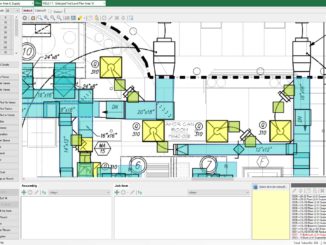By Norm Grusnick, PEng • Sales Manager, ECCO Supply

The goal of a good room air distribution system is to provide thermal comfort and a healthy living environment for occupants in the space. ASHRAE Standard 55-2017 Thermal Environmental Conditions for Human Occupancy and ASHRAE Standard 62.1-2019 Ventilation for Acceptable Indoor Air Quality provide design engineers with the guidance to optimize health and comfort in occupied building spaces. Many codes around the country require compliance with these ASHRAE standards. LEED also requires compliance with these standards. This article will briefly outline the goals of these standards and how to comply.
The occupied zone as defined by standard ASHRAE 55-2017 reads as follows: “The region normally occupied by people within a space, generally consided to be between the floor and six-feet level above the floor and more than three feet from outside walls/windows and one foot from internal walls.” The space from the interior walls inward one foot serves as a mixing zone where room air is entrained into the supply air stream and mixes to provide thermal comfort in the occupied space. When designing underfloor air distribution (UFAD) systems or thermal displacement ventilation (TDV) systems, the occupied areas around the outlets may be excluded to where the total air jet from the outlet contains velocities greater than 50 feet per minute (FPM). These are known as the “clear zone”.
Any design must also include an adequate supply of ventilation air to the breathing zone of the space. ASHRAE 62.1-2019 defines ventilation air as “that portion of supply air that is outdoor air plus any re-circulated air that has been treated for the purpose of maintianing acceptable indoor air quality.” The breathing zone is the six-feet area above the floor.
The primary factors to be considered when determining conditions for thermal comfort in the occupied space are: temperature, air velocity, humidity, clothing insulation, and activity level of the occupants. All of these factors are interconnected when determining the general occupant comfort of the space. The ideal temperature in a space is one in which the occupant will feel neutral to their surroundings. While the range of acceptable temperature may vary depending on other conditions, ASHRAE 55 requires the “allowable vertical air temperature difference between head and ankles to be 5.4 degrees F”. Air velocity in the space is less than 50 FPM during cooling and 30 FPM during heating. ASHRAE 55 requires the dew point to be less than 62.2 degrees F. Clothing variables also are factored in, from sandals to shoes. The final item is the activity level of the occupant in the space. Most office activity ranges from a 1.0 to 1.3 factor.
The three common methods of room air distribution used in commerical buildings are: fully mixed, fully stratified, and partially mixed, such as in underfloor systems. Design methods for cooling an interior zone and heating a perimeter zone vary with each method. For fully mixed systems, the pattern of the air delivered to the space must be considered when selecting the air outlets. Various options include ceiling diffusers, plenum slot diffusers, and side wall grilles.
Typically for perimeter applications where the same outlet is being used for both heating and cooling, a liner for plenum slot diffuser is used. For perimeter heating, the requirements for table 6-2 of ASHRAE Standard 62.1-2019 must be considered.
For partially mixed air distribution systems (typically UFAD), the core area usually experiences even loading throughout the occupied area. The goal of partially mixed systems is to save energy by conditioning the lower area through use of floor diffusers. Perimeter zones for partially mixed systems need special attention due to the outdoor solar and air temperature changes. Fully stratified design typically requires a separate heating system, but ventilation air can be reduced by 20%.
Regardless of which type of room air distribution system you use on your project, occupants who are comfortable are more productive. Comfort derived from good design keeps all occupants and users happy and healthy. ■



